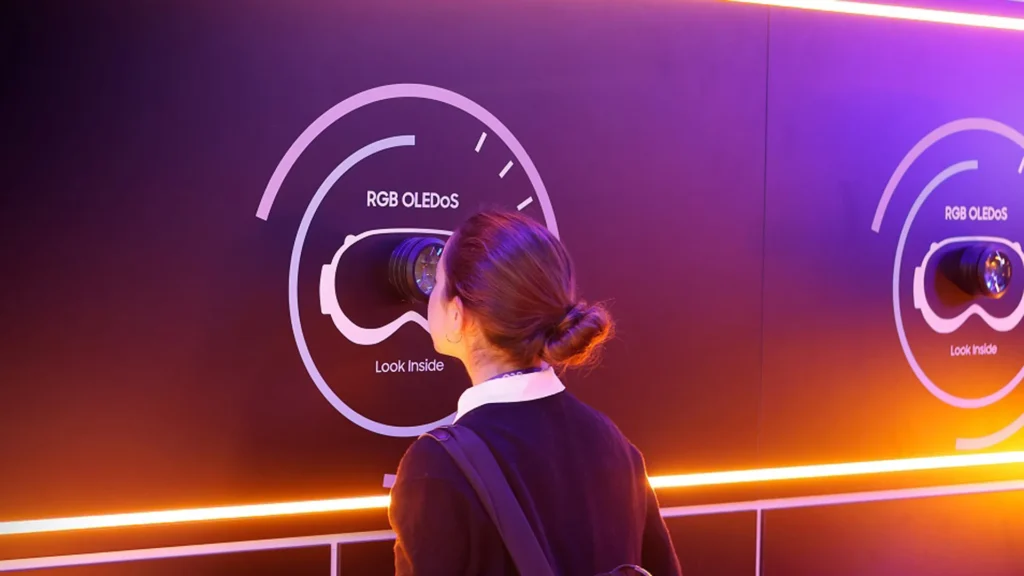-
Microsoft is partnering with Samsung to develop new metaverse hardware to rekindle interest in the metaverse space.
-
The partnership aims to develop cutting-edge hardware using Microsoft’s mixed reality experience and Samsung’s OLED technology.
-
OLED panels provide exceptional display quality, boosting user experiences with deep blacks, bright colors, and rapid reaction times.
Once the tech world’s darling, the metaverse has seen its hype dwindle recently. Tech behemoths that once invested heavily are now reassessing their short-term impact.
However, a recent report suggests that Microsoft is gearing up for a substantial comeback in the metaverse space.
According to sources, the company is collaborating with Samsung to develop metaverse hardware, potentially setting the stage for a new era of digital experiences.
Understanding Metaverse Hardware
Metaverse hardware comprises various components designed to facilitate immersive experiences in the digital realm. This includes mixed reality headsets, which blend physical and digital environments, and OLED panels, known for their vibrant displays and energy efficiency. These components are crucial for creating the realistic and engaging experiences that the metaverse promises.
In an age where digital interaction is increasingly vital, hardware is becoming more critical than ever. It enhances virtual meetings, entertainment, and education by providing immersive and interactive experiences. Companies like Microsoft recognize the urgent need to invest in this technology to stay competitive.
Also, Read: Cassava Technologies Boosts African AI Integration with New Business Unit.
Microsoft Teams Up with Samsung to Develop Cutting-Edge Metaverse Hardware
The Microsoft-Samsung partnership is designed to leverage both companies’ strengths to develop cutting-edge VR hardware. Samsung’s OLED technology, known for its high-quality displays, will combine with Microsoft’s mixed reality expertise. This collaboration aims to push the boundaries of what’s possible in the digital realm, creating hardware that offers unparalleled user experiences.

Microsoft has reportedly secured hundreds of thousands of OLED panels from Samsung. These panels will be integral to developing new mixed-reality headsets, offering stunning visuals and seamless integration between the physical and digital worlds. This partnership signifies a significant step forward in the evolution of metaverse hardware.
The mass production of this new device begins in 2026. Initially, the device will focus on content consumption, such as gaming and movie watching, rather than complete metaverse immersion. This strategic focus allows Microsoft to target early adopters and entertainment enthusiasts before expanding into broader metaverse applications.
The Role of OLED Panels in Metaverse Hardware
OLED panels have superior display qualities, including deep blacks, vibrant colors, and fast response times. These features make them ideal for mixed-reality applications, where visual fidelity and responsiveness are critical.
Imagine watching a movie with vivid colors that make it feel like the characters are in the room with you. Or playing a game where the environments are so lifelike you forget you’re wearing a headset. These scenarios illustrate the potential benefits of OLED technology in enhancing user experience within the metaverse.
Mixed Reality Headsets: A Window to the Metaverse
Mixed reality headsets are crucial for bridging the gap between the physical and digital worlds. They allow users to interact with digital objects as part of the physical environment. This technology is essential for various applications, including training simulations, design visualization, and interactive gaming.
Through this partnership, both companies aim to redefine the capabilities of mixed-reality headsets. By integrating advanced OLED panels, these headsets will offer unprecedented levels of immersion and realism, setting a new standard in the industry.
Also, Read Google and Magic Leap Metaverse Partner Up to Revolutionize AR and the Metaverse.
Microsoft’s Previous XR Ventures
Microsoft has a history of venturing into extended reality (XR). In 2017, the company partnered with Acer to produce the first PC VR headsets and launched the Windows Mixed Reality (WMR) platform. Despite initial success, the platform eventually lost traction, leading to its discontinuation.
The Tech Titan also developed the HoloLens, a mixed-reality headset for enterprise applications. While innovative, the HoloLens faced performance issues and internal layoffs. Even a promising partnership with the U.S. Department of Defense fell short, with soldiers reporting severe nausea and eyestrain after use.
Comparison with Competitors
Apple’s Vision Pro
Apple recently entered the mixed reality space with the $3,500 Vision Pro, marketed as a spatial computer. This high-end device represents Apple’s closest venture into the metaverse, emphasizing premium features and user experience.
Meta’s Investment in the Metaverse
Meta has been a significant player in the metaverse and XR through its Quest line of headsets. However, despite substantial financial investments, the company is scaling back spending and restructuring its approach.
Future Implications and Industry Impact
Microsoft and Samsung’s development of metaverse hardware could have far-reaching implications across multiple sectors. The potential applications are vast and varied, from entertainment and education to healthcare and retail. Enhanced virtual experiences could revolutionize how we interact, learn, and conduct business.
While still in its early stages, the widespread adoption of hardware seems likely as technology evolves. The Microsoft-Samsung partnership is a significant step toward making advanced metaverse experiences accessible to a broader audience.
Conclusion
In summary, this partnership is pivotal in developing the VR hardware. By combining Samsung’s OLED technology with Microsoft’s expertise in mixed reality, the collaboration aims to create innovative solutions that redefine digital experiences.
While the initial focus will be on content consumption, the long-term potential for complete metaverse immersion is immense. This partnership highlights Microsoft’s commitment to advancing display technology and staying competitive in the evolving XR landscape.
As we move forward, the impact of metaverse hardware will likely shape our digital experiences in ways we can only begin to imagine.
